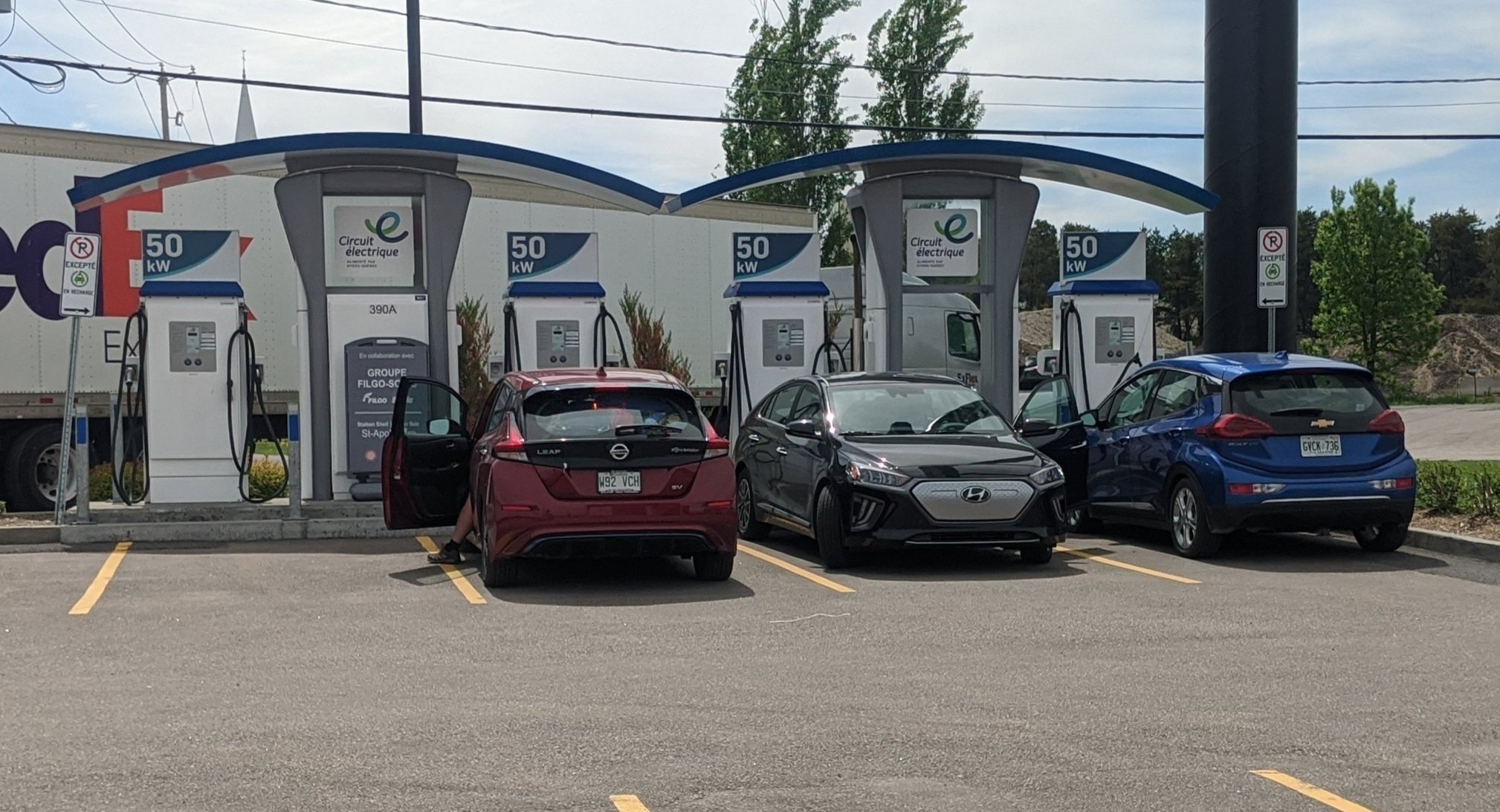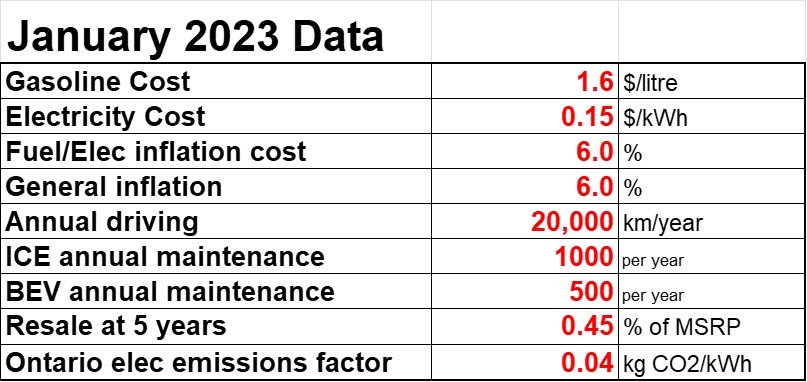
Buying an EV?
The 2024 updated EV Price and Range Chart is below
The Canadian EV Market
The market for EVs is one of the fastest growing ones in the world. Almost every major automotive manufacturer has one or more EV models for sale and the list grows all the time. Over 80 versions and models are available in Canada as of 2024 but more are on the way. There are also start-up EV manufacturers introducing both sedans, crossovers, SUVs and pickup trucks. If you’re new to the EV market, you’ll need to do some research to learn exactly what is available!
If you’re thinking of buying an EV:
See the 2024 chart below for an overview of range, price and charging rates for EVs available now in Ontario
“PlugnDrive” is an excellent centre in Toronto where you can test drive various EVs without the sales pressure of a dealership.
There is a federal rebate of $5k on the after tax price of any EV that has an MSRP of less than $55k or $65k. That’s the only rebate in Ontario. Quebec offers an additional $8k. B.C. and N.S. $3k.
There are a few dedicated used EV retailers, they can be found through internet searches.
Car sales search engines like Autotrader, Facebook Marketplace and Kijiji have a user selectable search filter to search only for EVs. Look for the “Engine Type” or “Fuel Type” filters.
Provinces with higher combined provincial and federal rebates are reportedly getting larger supplies of EVs from the manufacturers, therefore some people in Ontario buy used or new EVs through Quebec dealers who may have better supply.
EVs have similar powertrain warranties as gasoline powered cars and generally have an 8 year 160,000 km warranty or more on the main propulsion battery.
Used EV prices were quite high a few years back, but have settled down somewhat.
Cost and Range - 2024 update
The chart below shows March 2024 pricing (MSRP + delivery fee, minus the rebate, plus taxes in Ontario) for many EVs being sold new in Ontario. Prices are changing, some going up, some going down quite a bit lately, so please check manufacturers website for the latest information.
Many EVs come in a large variety of model options (standard range battery, long range battery, 2WD, 4WD, performance, etc.) Generally the lowest and highest cost versions of a model are shown. Let me know if you see any large errors. The ranges shown are those that Natural Resources Canada (NRCAN) has published based on standardized testing procedures. NRCAN has a very useful website where you can look up these ranges and also the estimated annual energy costs of operating an EV.
If you are looking for the lowest cost of transportation, notice that there is a small cluster of cars in the $40k - $50k range that have about 400 km range.
Life Cycle Ownership Costs
5 year year net cash costs for selected gasoline and EV cars
For 2023 prices, the chart shows expected 5 year cash costs for a few selected gasoline and EV cars. It is easy to see that at today’s gasoline prices of around $1.60/litre, lower priced EVs are the lowest total ownership cost and lowest greenhouse gas emissions option for personal transport.
To the left below are the cost data used for the calculations, if you want the actual spreadsheet to do your own work with it or check my math, send me an email with that request through the contact page.
If we apply similar inflation rates (i.e. 6% for 2023) to gasoline and electricity, we see hw much of a difference there is in favour of EV ownership.
January 2023 data used in the above 5 year ownership cost chart.
EV Maintenance
Initial indications from the approximately 10 years that EVs have been mass produced is that EVs are costing about 40% less to maintain. This is due to less mechanical complexity because there are fewer moving parts and the fact that EVs do not require regular oil changes or typically brake part replacements. There are also no engine air filters or spark plugs. More about brakes below….
Most EVs have very simple geared transmissions without nearly the complexity or parts count of conventional automatic or manual transmissions. There are no torque converters or clutches that are the common parts that wear out or fail in conventional gasoline engine cars.
Brakes
EVs have “regenerative” braking systems that take the kinetic energy of the moving car and use the electric motor as a generator to recharge the battery and slow the car down. This means the conventional friction disc or drum brake systems on EVs do much less work, which means the brake pads and rotors see little wear from actual braking. Because the EV brakes do less work, they do not heat up as much as gasoline car brakes and experience is showing that dampness and dirt are the long term enemies of EV brakes. In Ontario’s (and much of Canada and the northern USA) salty wet winter road conditions are the enemy of EV braking parts. If you buy an EV, make sure the brake systems (guide pins and pad clips) are cleaned and thoroughly lubricated once a year. Wash the salt off thoroughly in the spring at a car wash or have a mechanic do so for you. Eventually, due to corrosion, new rotors and pads will likely be needed, but it is the corrosion and seizing of the pads in the calipers that ruins the parts, not the wear from friction. In a similar way, through careful maintenance on my now sold 2001 Prius, I put over 200,000 kms on the original braking parts. At abut 12 years in Ontario, even with cleaning, corrosion ruined the discs.
Batteries
Many folks considering EVs worry about or believe the main traction battery will need to be replaced at some point, but all indications are that these batteries will last well over ten years. An ongoing study by Geotab shows battery loss of capacity for thousands of EVs. Loss of capacity is referred to as “degradation”. Some degradation is unavoidable, but large lithium based batteries in EVs do not have the short lives of laptop or cell phone batteries. Current data by Geotab shows about 10% battery capacity loss on average for 5 year old batteries, but newer EV models are showing degradation curves that indicate they will have less loss over time.
Almost all new EVs have batteries that are “thermally” managed. This means they are both heated and cooled by systems on the cars. This temperature management is part of prolonging battery life and maintaining capacity during colder temperatures. Some earlier EVs and one or two still in production do not have thermal management and indeed they have slightly higher battery degradation. In the moderate climate of southern Ontario we do not have to be too concerned about extreme hot or cold ambient temperatures that might shorten battery life. The fact that winter conditions reduce the driving range of the vehicles does not mean the batteries are being damaged, they just cannot deliver as many kWh when they are colder, and battery heating to maintain them at more optimal temperatures is included in most EVs. This battery temperature conditioning does not use much energy.
Some EVs have been recalled for faulty batteries, in particular the Chevy Bolt and Hyundai Konas received much publicity for the fact that about a dozen cars caught fire, apparently from battery failures. GM has replaced tens of thousands of the suspect batteries at no cost to the owners. In fact, the replacement batteries have 10% more capacity than the original batteries. Hyundai Kona’s have also been subject to a battery recall. Because EVs are so new, there are a few owners who have cars with high enough mileage that they have had battery failures outside of the warranty periods. If you’re concerned about battery life and potential replacement cost, think of the battery more like the engine of a good quality gasoline car, the engine will probably last the life of the car, but some engines in any population will fail, some within the warranty, some outside of the warranty. When those engines do fail, it may or may not be worth the cost of putting a used or rebuilt one into the car. The same is true with EVs. In cases where the overall vehicle is in good condition, it may be worth investing in a new or used battery. In other cases a car may be parted out at that point in its life, just like gasoline cars.
Presently, there are not millions of used EV batteries, EVs are just too new, but eventually there will be a huge volume of depleted batteries to recycle. Just like automotive lead acid starter batteries there will likely be value in the used EV batteries and many companies around the world are gearing up to recycle the anticipated large quantity of these batteries. Here’s a recent story on a Canadian EV battery recycling company. This is an evolving situation, but not a reason to not get an EV, the batteries will not be going into landfills.




